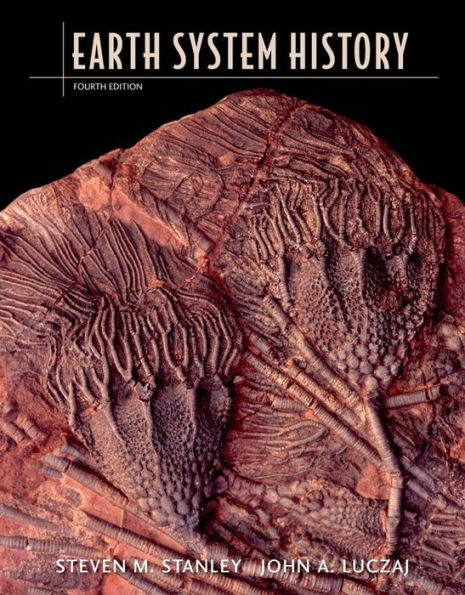Steven M. Stanley is a research professor in Paleobiology at the University of Hawaii. His research includes such areas as functional morphology; macroevolution; effects of changing seawater chemistry on biomineralization, reef growth, and lime sediment production; and the role of climate change in mass extinctions. He received an A.B from Princeton University in 1963 and a Ph.D. from Yale University in 1968. Before moving to the University of Hawaii he was on the faculty of the University of Rochester for two years and the faculty of Johns Hopkins University for thirty-six years.
Dr. Stanley has written three previous editions of
Earth System History and a total of three editions of its predecessors,
Earth and Life Through Time and
Exploring Earth and Life Through Time. His other books include Principles of Paleontology (with David M. Raup),
Macroevolution: Pattern and Process,
The New Evolutionary Timetable,
Extinction (nominated for an American Book Award), and
Children of the Ice Age: How a Global Catastrophe Allowed Humans to Evolve. He has been elected to the National Academy of Sciences and the American Academy of Arts and Sciences and has received a Guggenheim Fellowship and numerous awards, including the Paleontological Society Medal, the James H. Shea Award of the National Association of Geoscience Teachers (for books authored), the Mary Clark Thompson Medal of the National Academy of Sciences, the Twenhofel Medal of the Society of the Society for Sedimentary Geology, and the Penrose Medal of the Geological Society of America.
Dr. Stanley has taught courses in Earth History, Paleontology, Paleoecology, Macroevolution, Marine Ecology, Biodiversity, and Darwin and Darwinism.
John Luczaj is a field geologist interested in sedimentology, geochemistry, and hydrogeology, specializing in diagenesis in sedimentary systems. He has conducted research on hydrothermal dolomitization, fluid-inclusions in minerals, groundwater geochemistry and aquifer recovery, geologic mapping, geomorphology, and Holocene cave deposits. One of his important contributions was the first successful dating of diagenetic dolomite using the U-Pb method.
He received a B.S. in geology from the University of Wisconsin – Oshkosh in 1993, an M.S. in geology from the University of Kansas in 1995, and a Ph.D. in geology from Johns Hopkins University in 2000. He worked as a USGS-NAGT Summer Trainee at the Hawaiian Volcano Observatory in 1993, as a visiting assistant professor at Towson University (1999-2000) and Western Michigan University (2000-2002), and as an environmental consultant from 2002-2005 before joining the faculty at the University of Wisconsin-Green Bay. He is currently chair of the Geoscience unit in the Department of Natural & Applied Sciences at UW-Green Bay. In conjunction with the Wisconsin Geological & Natural History Survey, he completed a county-wide bedrock geologic mapping project in 2011.
Dr. Luczaj teaches courses in physical geology, historical geology, sedimentology & stratigraphy, glacial geology, regional field geology, and radioactivity. His current research focuses on the groundwater chemistry of confined aquifer systems in eastern Wisconsin, the diagenesis of sedimentary rocks, including petroleum reservoirs, and he has recently completed a review article on the geology of the Niagara escarpment in Wisconsin. He received the Vincent E. Nelson Award in 2001 from the American Association of Petroleum Geologists for his work on hydrothermal dolomitization.
John Luczaj is a field geologist interested in sedimentology, geochemistry, and hydrogeology, specializing in diagenesis in sedimentary systems. He has conducted research on hydrothermal dolomitization, fluid-inclusions in minerals, groundwater geochemistry and aquifer recovery, geologic mapping, geomorphology, and Holocene cave deposits. One of his important contributions was the first successful dating of diagenetic dolomite using the U-Pb method.
He received a B.S. in geology from the University of Wisconsin – Oshkosh in 1993, an M.S. in geology from the University of Kansas in 1995, and a Ph.D. in geology from Johns Hopkins University in 2000. He worked as a USGS-NAGT Summer Trainee at the Hawaiian Volcano Observatory in 1993, as a visiting assistant professor at Towson University (1999-2000) and Western Michigan University (2000-2002), and as an environmental consultant from 2002-2005 before joining the faculty at the University of Wisconsin-Green Bay. He is currently chair of the Geoscience unit in the Department of Natural & Applied Sciences at UW-Green Bay. In conjunction with the Wisconsin Geological & Natural History Survey, he completed a county-wide bedrock geologic mapping project in 2011.
Dr. Luczaj teaches courses in physical geology, historical geology, sedimentology & stratigraphy, glacial geology, regional field geology, and radioactivity. His current research focuses on the groundwater chemistry of confined aquifer systems in eastern Wisconsin, the diagenesis of sedimentary rocks, including petroleum reservoirs, and he has recently completed a review article on the geology of the Niagara escarpment in Wisconsin. He received the Vincent E. Nelson Award in 2001 from the American Association of Petroleum Geologists for his work on hydrothermal dolomitization.






